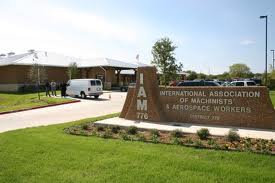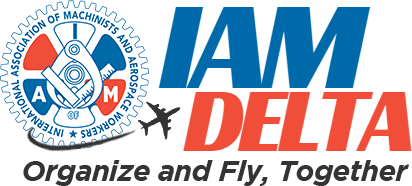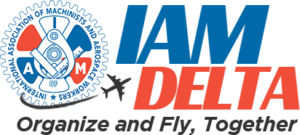 Your Local Lodge is the basic building block of the IAM. This is where IAM members meet every month, to share and debate ideas, vote on issues and
Your Local Lodge is the basic building block of the IAM. This is where IAM members meet every month, to share and debate ideas, vote on issues and
elect officers for all levels of the union, right up to the International President.
There are over 1000 IAM Local Lodges in every region of the United States, Canada, Guam, Puerto Rico, and Panama. Local Lodges range in size from fewer than 100 members to more than 10,000 members.
The Local Lodge has major responsibilities in the process of negotiating and enforcing the contracts that determine the wages, benefits, and other terms and conditions under which IAM members are employed. But most Local Lodges do much more than negotiate contracts and process grievances.
Your Local Lodge can be anything you want it to be. You can make this happen by attending meetings and becoming involved.
Your Local Lodge Officers are nominated and elected by you and your fellow members in a secret ballot vote. The officers include a President, Vice President, Recording Secretary, Conductor Sentinal and three Trustees. The officers’ duties are spelled out in “Article C” of the IAM Constitution.
Your District Lodge is the next building block of the IAM. A District Lodge is typically made up of several Local Lodges across a large geographical area.
IAM District Lodges use the principle of “strength in numbers” to better serve the membership. Uniting a number of Local Lodges into a single, larger unit allows more services to be delivered more efficiently to more members.
Because a district represents many workers across a large area, its members speak with a louder voice when dealing with elected officials at the local, state and national level.
Your General Chairperson is elected and employed full-time to protect, defend and advance the interests of the IAM membership. Among other duties, they negotiate contracts, process grievances and organize new members.
General Chairpersons are chosen according to local or district lodge by-laws, which are proposed, amended and approved by a vote of the membership. In larger districts, a Directing General Chairperson typically oversees several Assistant General Chairpersons.
The people holding these positions are primarily responsible to the local and district union membership, but they also serve under the general supervision of the IAM General Vice President in charge of their territory. In most cases, a portion of their salary is supported by the Grand Lodge (see below).
of the IAM General Vice President in charge of their territory. In most cases, a portion of their salary is supported by the Grand Lodge (see below).
Your Territory. The IAM is divided into territorial jurisdictions, each headed by a General Vice President. Six of the Territories are geographical regions (Eastern, Midwest, Western, Southern, and Canadian); one is industrial (Transportation) and one (Headquarters) has jurisdiction over IAM Headquarters operations in Upper Marlboro, Maryland, the U.S. Organizing staff and the William W. Winpisinger Education and Technology Center at Placid Harbor, in southern Maryland.
U.S. airline employees are part of the Transportation Territory.
Your Grand Lodge Representative (GLR) is one of the full-time staff employed by the IAM and assigned to the General Vice Presidents in the various territories. GLRs are responsible for contract negotiations, organizing, arbitrating grievances, and representing the IAM before the National Labor Relations Board and other vital activities. Before being appointed as a GLR, a person must have held continuous membership in the IAM for five years. They are paid directly by the Grand Lodge.
Your Grand Lodge Auditor (GLA) is one of the 17 full-time staff assigned on a geographical basis by the General Secretary-Treasurer to assist and serve the Local and District Lodges. The GLA’s duties include auditing local and district financial records and training financial officers.
The Grand Lodge or International is a term commonly used to refer to the top IAM leadership or to IAM Headquarters. Actually, the term Grand Lodge properly refers to the IAM Executive Council and the Local Lodge delegates duly elected and seated at regular or special IAM conventions. The term “the  International” properly refers to the entire IAM organization, which (spanning the U.S., Canada, Guam, Puerto Rico and Panama) is international in scope.
International” properly refers to the entire IAM organization, which (spanning the U.S., Canada, Guam, Puerto Rico and Panama) is international in scope.
The Executive Council is comprised of the nine General Vice Presidents, the International President and the General Secretary-Treasurer. The Executive Council is elected every four years by a direct, secret ballot vote of the entire IAM membership.
SOME OTHER KEY PIECES OF YOUR UNION
The major building blocks of the IAM are the Local Lodge; the District Lodge; the Territory, and the Grand Lodge. But there are other components of your life in the IAM you should know about immediately.
Your Contract will be one of more than 6,000 legally-binding agreements currently in effect between various employers and the IAM. Your contract secures your wages, hours, and working conditions. But most contracts also provide an extensive array of benefits, rights, and protections, including job security, vacations, holidays with pay, life insurance, medical benefits, pension rights, sick leave, severance pay, maternity leave, shift differentials, transfer and promotion rights, time off for voting, jury duty, savings plans, moving allowances, call-in pay, and many other benefits vital to the welfare of you and your family. As an IAM member, you have the right to propose changes to your contract when it comes up for negotiation. You have the right to help elect your negotiating committee. And you have the right to vote to approve or reject any contract under which you will work. And whenever a new contract is negotiated, you have the right to receive a copy.
Non-union workers live at the whim of their employers. Union workers have a legal, binding contract and an organization ready to back them up. Comparative studies of contracts negotiated by other unions show IAM contracts are as good as any and better than most. Your contract is your bill of rights on the job. Get a copy. Study it. Know it.
Your Shop Steward is your front-line representative. The steward’s primary responsibility is to enforce the union contract and protect you and your rights. If you have a problem on the job, see your shop steward. If necessary, the steward will work to resolve your complaint through the “grievance procedure” set forth in the contract. Your IAM steward also is a key source of information and advice about news and events in your union. If you have a question or wish to become more involved, talk with your steward.
Your State/Provincial Machinists Council is one of 44 such organizations, including 40 state councils in the United States and four provincial councils in Canada (British Columbia, Manitoba, Ontario, and Quebec). State or provincial councils are made up of delegates from IAM locals in a given state or province. Most meet at least twice a year.
Council meetings exchange information and coordinate action on economic, political, and legislative matters affecting the welfare of IAM members and working families, generally.
Machinists Councils have initiated many improvements in state and provincial laws affecting health and safety, workers’ compensation, fair labor standards, and other vital areas of concern.
Regional Machinists Councils also exist, serving all of Canada, New England, and the Eastern, South Central, and Midwest states.
Your link to Members of Other Unions locally or in your state or province is through the IAM’s affiliation with the American Federation of Labor-Congress of Industrial Organizations (AFL-CIO) in the United States and the Canadian Labour Congress (CLC).
The AFL-CIO and the CLC are not unions. They are umbrella organizations of many unions representing several million workers, which seek to build a stronger labor movement by coordinating such activities as political action, worker education, organizing research, rallies, and other mass mobilizations.
The AFL-CIO and the CLC are organized into local and state/provincial labor councils, forming a powerful grassroots network of workers in shops and communities across the continent. Sixty-eight unions are currently affiliated with the AFL-CIO, headquartered in Washington, D.C., and 60 are affiliated with the CLC, which is headquartered in Ottawa.
The IAM is also an affiliate of the International Transport Workers Federation (ITF). The ITF is a global organization that advocates for transportation workers around the world.

